What is a mucus plug?
During pregnancy, a mucus plug forms. It is a lump of mucous structure and viscous consistency, which at first glance resembles the white of a raw egg. A mucus plug is formed and located in the cervical canal, which connects the vagina to the sterile uterine cavity.
When the embryo implants and firmly attaches to the uterine cavity, the cervix undergoes softening and swelling of its walls under the effect of hormones. Cervical cells actively begin to produce cervical mucus. Over time, it becomes an increasingly dense clot that is capable of completely closing the entrance to the uterine cavity from the side of the female vagina.
The cork has a protective function : a woman’s body in this position is most susceptible to various infectious diseases, and it does not allow microorganisms to make their way inside the uterus. This can even happen when a pregnant woman bathes in a home bath.
Also, the mucus contains ready-made antibodies, which actively enter the fight in the event of penetration of a pathogenic pathogen . The composition of the mucus plug is renewed throughout pregnancy, because the cells continue to actively produce their cervical secretions. Thanks to this, the cork performs all its necessary functions.
Closer to the natural end of pregnancy, the concentration of the hormone estrogen increases, which helps soften this mucus, so the plug becomes more watery and comes out on its own. This occurs on average several days before labor occurs.
A plug may be released as a result of:
- frequent examinations by a gynecologist;
- excessive contraction of the vaginal muscles during sexual intercourse in a pregnant woman;
- physical activity and other factors.
Rejection of the mucus plug does not mean a complete loss of protective properties; the amniotic sac and the amniotic fluid that fills it also have this function.
But experts still recommend refraining from being in bodies of water or taking a bath: infections during this period are easier to penetrate into the uterus.
Functions of cervical mucus
The secretion produced by the cells of the cervical canal has different colors, volumes and consistency depending on the day of the menstrual cycle. At the beginning, very little fluid is produced, and the woman may even have none at all.
The environment in the vagina during this period is acidic, it is destructive for sperm. During and before ovulation, the production of cervical secretion is maximally active, the fluid becomes more transparent, and its volume increases. This creates a favorable environment for sperm to penetrate into the egg.
At this time, pregnancy is most likely to occur. As you approach the end of the cycle, the mucus changes its consistency to a more viscous, thick one. This occurs due to a decrease in the amount of estrogen. The pH again drops to the acidic side, creating an obstacle to the passage of sperm.
The main function is considered to be protective - a certain barrier is created that prevents the uterus from getting pathogenic agents from the vagina into it.
Also, on certain days of the cycle, it promotes the penetration of sperm to fertilize the egg.
The alkaline nature of mucus protects sperm from the vaginal environment, which under physiological conditions is acidic. There is a kind of screening out of sperm that are not mobile enough, and therefore do not have sufficient viability for fertilization.
Mucus plug color
There are no universal parameters. The literature states that the physiological mucus plug is characterized by a transparent color, but practicing gynecologists claim that color changes can range from beige to slightly brown. No pregnancy pathologies are observed in such cases.
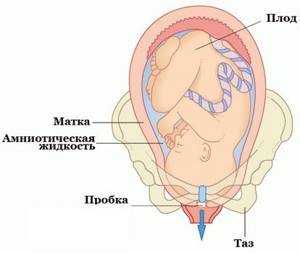
Women often note blood streaks in the removed plug. There is no need to worry and immediately contact a gynecologist in this situation: their appearance is associated with injury to small vessels in the cervical area when the plug is separated. This may also indicate the upcoming shortening and maturation of the cervix for childbirth.
Volume
In most cases, the volume of the released plug is small, approximately 50 ml. The mucus is secreted in a dense lump; it does not spread and is not absorbed into the fabric, so women usually see it immediately on their underwear. The size of the released plug is about 2 cm.
Consistency
The structure of the mucous lump is viscous and thick. Its separation is quite difficult to miss: a jelly-like lump will be visible on the underwear, which differs from the woman’s usual discharge. This will differ from the amniotic fluid that flows immediately before birth.
What to do when the plug comes out
Unprotected sex and visiting pools or other open bodies of water are not recommended during this period. The bath should also be replaced with a shower in order to minimize the risk of infections entering the uterus. There is no point in further mentioning personal hygiene, since its importance is already obvious. For the rest, although information about how long it takes for labor to begin after the plug comes out is important for the expectant mother in labor, its removal is not a reason to immediately call an ambulance.
If there are no other signs that the baby is planning to be born soon, then you can continue your previous lifestyle. Without medical indications, hospitalization in this case is not required, however, collecting things and preparing everything necessary for the birth and meeting the baby is more than advisable. With the removal of the plug, a “countdown” begins, measuring the days until the end of pregnancy.
How to cope with pain?
The cervical mucus cleared and the woman went into labor. During contractions, a woman in labor usually has pain in her lower back and a tightening in her lower abdomen; this process is associated with pain. Is it possible to relieve pain during contractions? There are 2 groups of labor pain relief methods. Medication methods:
- epidural administration of anesthetics;
- spinal block;
- Pethidine injections;
- gas anesthesia with nitrous oxide.
Non-medicinal methods include:
- psychological preparation;
- massage;
- transcutaneous nerve stimulation (TENS);
- aromatherapy;
- hypnotherapy;
- impact on reflex zones;
- water birth;
- yoga.
Each of these methods has its pros and cons. Before choosing any method of pain relief, including non-medicinal ones, you must consult a doctor to identify possible risks and contraindications.
Does she always leave
The fact is that the mucous mass always comes off, but the question is the timing and attentiveness of the expectant mother. It happens (especially for those who are carrying a baby under their hearts for the first time) that the clot does not come off all at once, but gradually, in this case it is easy to confuse it with normal vaginal secretion. A young mother may simply not notice such an event. In another option, the lump moves away just before the baby is born, when contractions are in full swing and the cervix dilates. In any case, everything is purely individual, and no one can tell how this process will happen for you.
What to do if the plug comes off
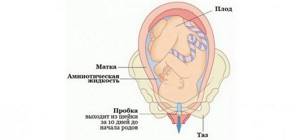
But you can visit the antenatal clinic for prevention. But usually it is enough to notify your obstetrician-gynecologist about this event, at least by telephone. Just don’t go for a walk without an exchange card yet and practice how to breathe correctly during labor and childbirth, the first bell to this process has already rung. In addition, it is important to understand that after a lump of mucus has passed, the cervix is already slightly open, so it is important to follow simple precautions :
- say a firm “no” to sex life (if you live it even at such a late stage);
- do not swim in the river, pool or bath, only shower;
- change your underwear more often;
- pay a little more attention to personal hygiene.
Remember: the barrier that protected the baby from everything that happened throughout the gestational period in the vagina is now missing. Yes, there is still a placental barrier, but nevertheless, you have to be careful. The passage of a clot not only warns that childbirth is around the corner, but also places additional responsibility on you for the health of the baby, remember this.
If you haven't left
There may be two options here. Either the plug has come away, the woman simply did not notice it, or it remains in the cervical canal due to the slow softening of the uterus, high levels of progesterone and low levels of estrogen.
There's no need to panic. If contractions begin with a plug, nothing bad will happen, because it will come out as the cervix opens, usually this happens within the first 1-3 hours from the start of the latent (hidden) period of contractions.
If by some miracle the plug remains in the canal, then it will definitely leave it when the amniotic fluid is released under the pressure of the amniotic fluid itself. In this case, nothing needs to be done. Just wait.
Some women are successfully treated with “husband therapy,” because men’s semen contains prostaglandins, which help soften the uterus. If there are no contraindications to intimate life, this method may well be used.
Some are helped by increased activity right up to childbirth - women wash the floors, tidy up, bring shine and beauty to the children's room, where a new family member will soon arrive. Any work within your power is welcome, the main thing is not to move the cabinet or move the piano into the next room.

If the plug does not come out by 41 weeks and labor does not begin, the woman is hospitalized, examined and a decision is made to induce labor at 41-42 weeks. After this period, according to existing standards, the pregnancy is considered post-term.
Against the background of preparation in the hospital, aimed at faster ripening of the cervix, if for some reason it is “delayed”, many note that the mucus plug comes off literally a day after the start of therapy.
Labor can begin on its own within 1-3 days. Otherwise, they are stimulated by intravenous hormonal agents.

Signs of removal of the birth plug
Removing a plug from the cervical canal of a pregnant woman is a harbinger of an imminent birth. Often the mucous lump comes off when a woman wakes up, during morning water procedures, or when visiting the toilet. The body is in a relaxed state in the morning.
The mucus plug can come away in one moment, and the woman understands that something seems to have fallen out of the vagina. After this, a lump of mucus is found on the underwear, which differs in size and consistency from daily discharge. When the plug is removed, a woman may experience discomfort, a sensation of stretching in the lumbar area or uterus.


In some situations, it turns out that cervical mucus is released gradually over the course of several days. When collecting anamnesis, it turns out that discharge from the genitals has become more abundant and more frequent. The pregnant woman herself may not attach any importance to this, thinking that the plug has not yet come out.
To convince yourself that the plug has fallen out, you can conduct a simple test: if a woman coughs and no new discharge appears, then there is no need to rush to the maternity hospital.
How does it turn out for first-time mothers?
In a certain percentage of women who are about to give birth for the first time, the plug comes off at a later date ; this can happen directly at one of the stages of labor. Their cervical opening is narrow, and its walls are denser in comparison with women who are expecting the birth of a child not for the first time.
In primigravidas, the plug more often comes off with blood streaks , but women often do not notice the presence of negative symptoms in the form of pain and heaviness. It can separate either gradually in parts or as a single clot.
How does it work out for multiparous women?
In women with a history of one or more pregnancies, the walls of the cervical canal have a looser structure. Their mucus plug is most often released at once, while admixtures or streaks of blood are rarely observed.
Helpful information
As you get used to all the harbingers of labor, there is a fearful feeling of not noticing the onset of labor itself behind them. All the conditions for the development of labor have already been created in the body and the balance becomes unstable, ready to be disrupted towards childbirth at the very near moment.
You can reliably determine that labor has already begun by observing the dynamics of cervical dilatation through a vaginal examination. Only a specialist can do this. But the woman in labor herself is able to note the symptoms that it is time to contact such a specialist - go to the maternity hospital or call him at home. By what signs can you understand that labor has already begun?
- Mucus plug. 1-3 days or several hours before giving birth, mucus resembling egg white may begin to be released from the woman’s genitals; it may also be brownish, similar to menstrual smear, or it will be a mucous discharge, stained with slight streaks of blood. It can come out with a pop (really, as if a plug had popped out, which is associated with the force of intrauterine pressure caused, for example, by the large weight of the fetus - over 4.5 kg), or it can flow out gradually, in small portions. The appearance of a mucus plug indicates that the cervix has begun to dilate. This is a definite sign of labor beginning. The abundance of discharge and the characteristics of its appearance are individual. In quite rare cases, the secretions of the cervical glands are so scanty that the mucus plug does not appear at all before childbirth. In this case, it may not appear during them either. In other cases, on the contrary, the ripening of the cervix occurs very slowly, and the secretion of its glands is very intense. In this case, the mucus plug may begin to come out 7-14 days before labor begins. However, in the vast majority of cases, the mucus plug appears with the onset of labor or several hours before it begins.
- Contractions. Undoubted evidence of the onset of labor is regular contractions, i.e. periodic contractions of the uterine muscles, occurring with a steady rhythm. Labor contractions are always accompanied by dilatation of the cervix and cannot be neutralized by relaxing procedures, such as taking a warm bath. But if a woman has had false contractions several times the day before, it can be difficult for her to navigate her feelings and distinguish between labor pains. If the appearance of contractions is accompanied by brown discharge from the genitals, then we can speak with complete confidence about the onset of labor.
- Digestive system. On the eve of childbirth, as a rule, bowel movements occur. A woman may go to the toilet repeatedly, and at the same time the stool will come out in a slightly larger volume than usual. Immediately before the onset of labor, i.e. several hours before the onset of labor contractions, nausea, vomiting, complete loss of appetite or stomach upset may occur. This reaction of the digestive system is associated with the action of hormones that stimulate labor. The listed phenomena can occur both together and separately and accompany the appearance of the first weak contractions. In addition, the first contractions may be felt as abdominal pain, increased peristalsis and frequent empty urge to go to the toilet.
- Pain. Sometimes labor begins with the appearance of vague dull pain in the lower abdomen and lower back or girdle pain (lower abdomen and lower back). They can be periodic in nature, or they can serve as a painful background, i.e. continue without ceasing.
- Chills. Quite often, all these phenomena are accompanied by a feeling of cold and chills. Labor chills may accompany the onset of labor.
- "Dropping" of the abdomen. A woman may notice that her stomach has moved downward. “Descent” of the abdomen occurs due to the lowering and insertion of the presenting part of the fetus into the inlet of the small pelvis and the deviation of the uterine fundus anteriorly due to a slight decrease in the tone of the abdominal press. The child begins to descend deeper into the pelvic area. In primigravidas, this is observed 2-4 weeks before birth. For those giving birth again - on the eve of childbirth.
- It becomes easier to breathe. By moving the baby down, pressure is relieved from the diaphragm and stomach. It becomes easier to breathe. Heartburn may go away. This increases pressure on the lower abdomen. Sitting and walking become a little more difficult. After the baby is displaced downwards, a woman may experience difficulty sleeping; at this time it is difficult to find a comfortable sleeping position.
- Frequent urination and defecation. The urge to urinate becomes more frequent as pressure on the bladder increases. Childbirth hormones also affect a woman’s intestines, causing the so-called pre-cleansing. Some women may experience mild abdominal cramps and diarrhea. Almost like before an exam.
- Pain in the lower back. After the baby is displaced downwards, the woman may experience uncomfortable sensations in the lower back. These sensations are caused not only by pressure from the child, but also by increased stretching of the sacroiliac connective tissue.
- Changes in fetal motor activity. The baby may either calm down a little or move very actively. It is as if he chooses the rhythm and the most suitable moment for his birth.
- Change in appetite. Appetite may change just before giving birth. More often, appetite decreases. It’s good if a woman at this time trusts her intuition more when choosing products. You shouldn't eat for two.
- Reducing body weight. Before giving birth, a woman may lose some weight. A pregnant woman's body weight may decrease by about 1-2 kg. This is how the body naturally prepares for childbirth. Before childbirth, the body must be flexible and flexible.
- Unexpected change of mood. The woman is looking forward to “her time.” She can’t wait to give birth (“I wish I could hurry up…”). The mood may “suddenly” change. Changes in mood are largely associated with neuroendocrine processes occurring in the body of a pregnant woman before childbirth. Explosions of energy are possible. The state of fatigue and inertia can suddenly give way to vigorous activity. The “nest” instinct appears. The woman is preparing to welcome the baby: she sews, cleans, washes, tidies up... Just please don’t overdo it.
- Discharge of water. The amniotic sac may leak, then the water will slowly flow out. It may burst suddenly, then the waters will “gush out in a strong stream.” Sometimes this happens before the rhythmic contractions of the uterus begin. This occurs more often in multiparous women. When the amniotic sac ruptures, no pain is felt. If your water breaks immediately, before the onset of rhythmic contractions, you should go to the maternity hospital immediately!
Differences between plug and amniotic fluid
Some women, especially nulliparous women, confuse processes such as the rupture of amniotic fluid and the release of a mucous clot.

The release of the mucus plug and the discharge of amniotic fluid should not be confused. If the plug comes off, this does not mean that labor is imminent, while the outpouring of water indicates the beginning of labor.
You need to be able to differentiate these conditions, because their further tactics are completely different:
| Evaluation parameter | Cork | Amniotic fluid |
| When does it leave | A few days before labor begins | At the beginning of labor |
| Consistency | Viscous | Watery |
| Color | Slimy beige, possibly streaked with blood or a brownish tint | Normally the waters are clear |
| Periodicity | At once or portionwise over several days in small clots | There is a symptom of a cough impulse, constant leakage |
| Further actions | Observation | Head to the maternity hospital |
How to distinguish the onset of labor?
Let us remember that the most important signs are the breaking of water and the appearance of regular contractions, which gradually open the uterus. But before real contractions, false ones arise. How can a woman, especially during her first pregnancy, distinguish them? The difference between them is as follows:
- Real contractions are characterized by a cyclical rhythm: at first they appear once every 10 minutes, then after 5 - the interval between them decreases, and the pain intensifies. The beginning of the spasm is felt in the back, gradually moving to the stomach.

- False, training, contractions occur at unequal time intervals, without causing pain. The duration of each is also different. The randomness of the appearance is revealed only by a tense stomach. But after a few seconds there is relaxation. Such contractions can appear even in the early stages. They help the uterus prepare, but do not open it. Hiking and warm baths, with a water temperature of no more than 36 degrees, help get rid of discomfort.
If false contractions cause anxiety in a first-time mother, it is better to contact your specialist, who will determine whether to stay in the maternity hospital or go home for now. Although in case of false contractions they are usually put into storage.
[media=
https://youtu.be/xLhxRG08PAw
]
How long will it take for labor to begin after the plug comes out?
The beginning of the process of removing the plug from the cervical canal is a signal of major hormonal changes in the body of a pregnant woman. The number of estrogens is steadily increasing, and the amount of the pregnancy hormone progesterone is decreasing. These changes are necessary to prepare the birth canal and uterus for the upcoming birth.
The plug has come out, but it is unknown when labor will begin, since everything happens very individually for each woman.
Therefore, for some, labor develops a couple of hours after the recorded passage of the plug, and some pregnant women can arrive at the maternity hospital three weeks after the separation of a dense clot.
What to do after the plug comes out
The mucus plug can be removed from the cervix both before the immediate birth and in advance of it. For this reason, you need to pay attention to additional symptoms. If, after the mucous lump has passed, there are no unpleasant symptoms in the form of increasing pain in the lower back, as well as in the lower abdomen, then you should relax.
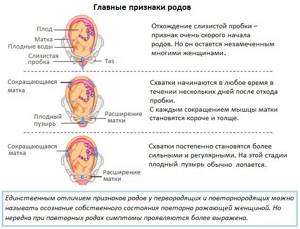
It is impossible to miss the onset of labor, even if it begins at night. If the above symptoms begin to bother you, then most likely this indicates the onset of labor. You need to start preparing for the maternity hospital, having first called a doctor to your home.
The plug has come out (a woman needs to know when labor will begin in order to react in time), and, therefore, a number of rules must be followed:
- Completely limit water procedures in any bodies of water, do not take a bath even at home. You should limit yourself to just washing yourself in the shower, and the stream flow should not be directed directly at the entrance to the perineal area.
- Refrain from sexual contact. Male secretions may contain microorganisms and other substances that can adversely affect the unborn baby.
- Be more careful about the cleanliness of underwear and change it more often to prevent the penetration of the provocateur of the infectious process into the uterus.
- Wash yourself at least twice a day, observing the first rule.

This is necessary so that no infection gets through the softened cervix, which is most vulnerable in the last stages of bearing a child. Contractions begin regardless of the desire of the pregnant woman, so the woman must be ready to go to the maternity hospital at any time.
The plug has come off (not a single obstetrician will tell you when labor will begin) - which means the woman needs to collect all the documents and other things for the maternity hospital, since this is often a harbinger of an imminent birth.
How to behave?
There is not much time left before the birth. How to carry it out so as not to harm the child, since there is one less protective barrier? Gynecologists advise following the recommendations:
- Replace bathing with a shower to avoid infection in the genitals;
- for the same reason, prohibit swimming in any bodies of water;
- carefully observe intimate hygiene;
- change bedding more often.
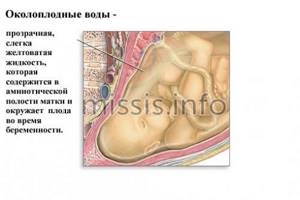
Still, there is no need to worry, because the baby is reliably surrounded by amniotic fluid
, not only protecting it, but also supplying it with the necessary nutrition.
During the prenatal period, doctors recommend moving more. Walking in the fresh air for 1-2 hours normalizes a woman’s general condition, improves her mood and calms her down. Physical activity will better prepare you for childbirth than lying on the couch.
Are there cases when the plug does not come out?
The plug exists in the body of every pregnant woman, so its removal from the cervical canal also necessarily occurs in everyone. In its absence, pregnancy would be almost impossible due to the fact that the infection would constantly penetrate upward into the uterine cavity.
Some women simply do not notice the moment of its departure. Most often, the mucus plug is released in the morning: when going to the toilet, and also happens when taking a shower. There are situations when a mucous lump comes out immediately before the baby is born. This is not a pathological condition.
Functions of cervical mucus
The vaginal mucus plug actually acts as a plug
. Under the influence of hormones, it begins to be released already in the first trimester of pregnancy by the walls of the cervix. Moreover, it becomes so viscous and thick that it blocks the entrance to it.
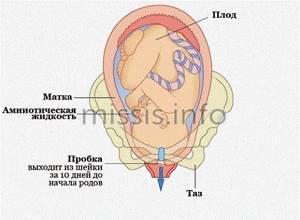
By the end of pregnancy, the plug is a mucus of a very dense consistency. This is a strong protection of the fetus from bacteria and viruses that enter the vagina, because it contains biological active substances: immunoglobulins, mucin, prostaglandins, which have a bactericidal effect. The cork comes out only before the birth itself, opening the way for the baby. This physiological phenomenon is one example of the wisdom of nature.
The removal of a mucus plug is often an unnoticeable process. Mucus may break out in the toilet or shower, then the pregnant woman may not understand what happened. Otherwise, a mucous clot can be found on the underwear, shapeless, transparent or light yellow, sometimes with small blood streaks, if small capillaries have burst in the uterus.
If there is a lot of blood in the mucus plug, you should immediately inform your gynecologist.
You can confidently say that labor has begun only when contractions become regular and the amniotic fluid breaks. How can you tell during your first pregnancy whether the plug has come out and not the amniotic fluid (this is what the liquid environment around the fetus is called)?
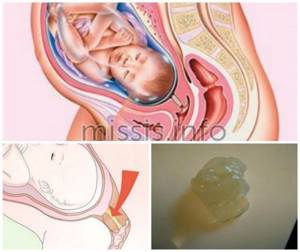
When to see a doctor
There are several situations in which the help of a specialist will be necessary to preserve the health of both the woman and the child:
- If there is a suspicion that a mucous clot has separated from the cervical canal, and there is still more than a month before the expected due date. This situation is dangerous because the uterus will remain in an unprotected state for a long time, and there is a high risk of inflammatory processes occurring during pregnancy. This may also indicate the onset of premature labor.
- Suspicious coloration of the mucus plug. For example, a scarlet color may indicate that bleeding has begun due to placental abruption. Here you may need urgent help from specialists, so the best solution would be to go to the maternity hospital. Also, a mucous lump can get this color due to an examination in a chair by a gynecologist. The cervix is quite tender, so any careless movement can cause microtrauma to the mucous membrane with damage to small capillaries, as a result of which the mucus plug acquires a scarlet tint due to the soaking of this lump with blood.

It is important for the expectant mother to maintain a positive attitude throughout her pregnancy and listen to her body.
If symptoms appear after the plug comes out that are embarrassing or cause discomfort, it is better to consult a gynecologist.
Only he is able to assess the condition of the pregnant woman, more accurately say when labor will begin, and also assume all possible risks to the health of the unborn child.
Article design: Svetlana Ovsyanikova
How are the second and third births?
Every woman who has had a difficult first birth and wants to have more children is interested in how the second and third ones go, how they begin, and how difficult they are. There is a myth that the second and subsequent labors begin prematurely. This is not true, since the timing of the birth of children is strictly individual.
If the first birth was complicated, then the second one begins the same way as the first time. Complications are taken into account by the doctor to prevent, for example, tissue rupture or fetal hypoxia. And in the physiological process itself, the difference is visible in the time and manifestations of symptoms. If there is a small gap between the children, the tissues are stretched, there is a possibility of an accelerated birth of the child.
If we talk about how the third birth begins, then nothing new can be discovered in this matter: the birth of any child is repeated with the same symptoms. A mother with many children should take more care of herself and listen to the obstetrician in order to prevent complications of the third birth. The complexity of the course and end of pregnancy depends on the woman’s health and age.










